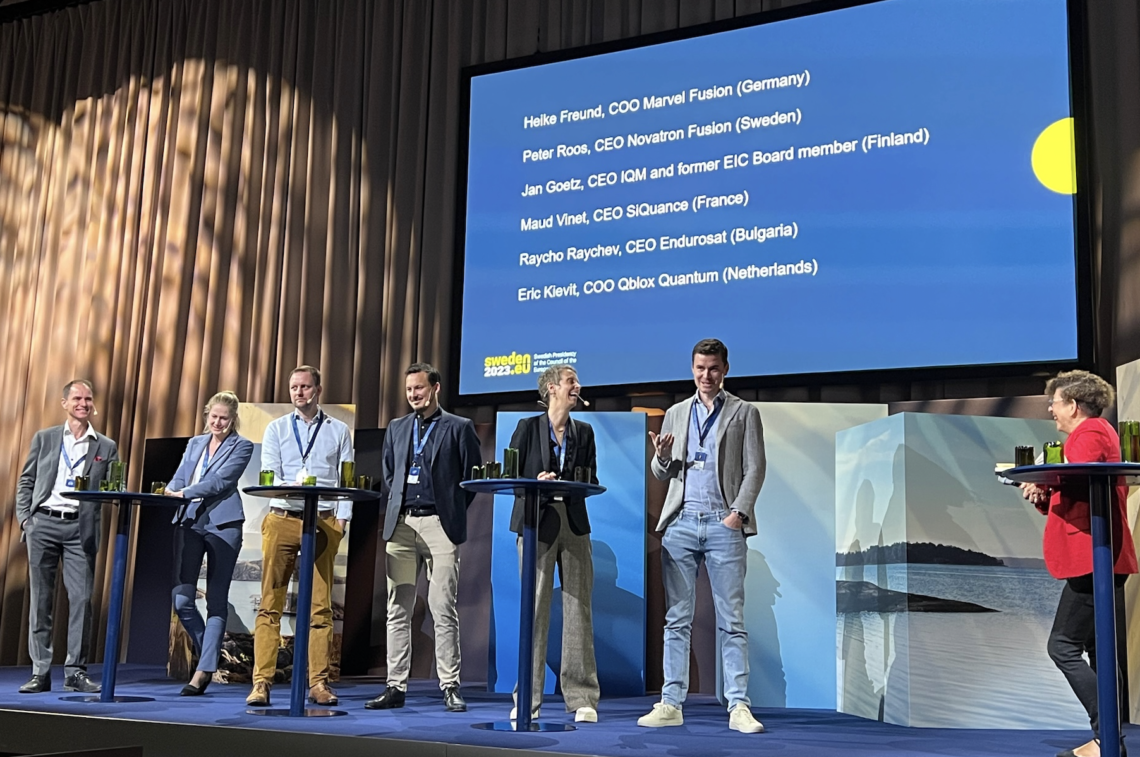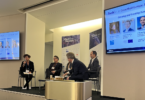The Swedish Presidency of the Council of the European Union organized a deep tech entrepreneurship conference in Stockholm June 1 and 2 that focused on the opportunities and challenges posed by deep tech and the need for new models of collaboration between startups, corporations, universities, tech hubs and incubators.
The Innovator’s Editor-in-Chief moderated four panels at the event which was attended by about 500 EU policy makers, corporations, investors, and other innovation leaders, including Competition Commissioner Margrethe Vestager, who also serves as Executive Vice President of the European Commission for A Europe Fit for the Digital Age.
Deep tech refers to emerging technologies based on scientific discoveries or breakthrough engineering innovations, offering a substantial advance over established technologies that can help tackle some of the world’s biggest challenges. It includes artificial intelligence, advanced materials, biotechnology, quantum computing and fusion, among other technologies.
Deep-tech products are often developed by PhDs and other highly qualified experts and they tend to take more time and capital to develop, as they often require in-depth testing and periodic reviews. Many deep-tech initiatives have their roots in academia and are funded by government grants. Products’ time-to-market can be long, and the ventures carry a lot of risks — risks that can be compounded by a lack of business expertise.
Yet the potential is so great deep tech it can’t be ignored. Fusion could provide a near-limitless, safe, clean, source of carbon-free baseload energy and is recognized as a potential game-changer in addressing climate change and rising global energy demand while quantum computing has the potential to solve the world’s biggest problems, such as developing targeted drugs more cheaply and quickly and combating climate change.
These technologies are strategic to Europe’s economic competitiveness and sovereignty.
“There is tremendous potential in this new era,” Sweden’s Deputy Prime Minister Ebba Busch, told the audience. “We need to think differently than in the 1980s when we let digital leadership slip out of our hands and future proof EU’s industrial leadership,” she said.
State Of Play
While the opportunities are great so are the challenges.
There are about 10 global artificial intelligence large language models. None are European. China, is investing more than double the EU in quantum computing. ($15.3 billion compared to $7.2 billion).There are currently 35 fusion startups worldwide. Only a few are in Europe. AI, fusion, and quantum computing companies are all struggling to raise as much capital as their competitors outside Europe. Private investors in the U.S. have deeper pockets and the U.S government is courting some of Europe’s best deep tech companies. For example, it has earmarked $1.4 billion for its domestic fusion industry and U.S. officials from several states are attempting to attract foreign groups to America by touting deep tax breaks and subsidies available to them from the U.S’s Inflation Reduction Act. The Act will provide about $370 billion of subsidies, some of which has been set aside for clean energy, such as the fusion industry, marking America’s most ambitious effort yet to tackle climate change.
Startups with intellectual-property assets generate 68% more revenue but only 9% of EU startups have these kind of assets, Daren Tang, Director General at the World Intellectual Property Organization (WIPO), told the audience.
And while Europe has impressive strengths in scientific and technological research it is estimated that nearly 95% of the existing patents in Europe are inactive. Among the reasons: private investors tend to be unwilling to take on research projects, which are usually characterized by high risk, huge expenses and long-term gestation periods. As a consequence, researchers often lack the resources required to locate and validate the right market for their discoveries — an innovation gap sometimes referred to as Europe’s Valley of Death, Josemaria Siota, Executive Director of IESE Business School’s Entrepreneurship and Innovation Center, said in a keynote address.
Europe has not just lagged in digital, said speaker Tomas Naucler, a senior partner at McKinsey. Europe was an early leader in clean tech technologies such as solar PV and offshore wind but China has surpassed it.“We have not been as ambitious enough as industry leaders or startup leaders,” he told the audience.
The Role Of Corporates
IESE’s Siota talked about the important role corporates have in helping Europe’s startups scale-up. However, about 70% of corporate collaborations with deep tech companies fail. One way of fixing this problem is the creation of corporate venturing squads, a novel structure that involves corporations teaming up to innovate with startups as a possible route to increase the corporate scouting capabilities, reduce the testing cost, and strengthen the corporate value proposition for startups, says Siota.
For example, Volvo has banded together with the automobile companies CEVT and Veoneer, as well as the telco Ericsson, to form mobilityXlab, offering acceleration support to entrepreneurs while nurturing innovation in corporations. Such corporate venturing squads – small group of companies that have joined forces to innovate with startups – can improve the value proposition offered to an entrepreneur by aggregating value (e.g., complementary areas of expertise in the companies). A squad also shares the cost of the proof of concept among its members, simultaneously strengthening the companies’ access to startups by leveraging the scouting capabilities of each member. A helpful way to reduce potential friction between squad members is choosing and grouping them in either dissimilar sectors or different parts of the value chain, according to an IESE study.
During a panel discussion Celine Farcet, Global Head of Technology Partnering, Open Innovation, at L’Oreal said such collaborations are needed. L’Oreal is sourcing innovations from a variety of deep tech startups. Often the innovations were nor developed for the beauty sector and need to be both adjusted to become fit for purpose and scaled, requiring cross-industry collaboration.
The Need For Innovative New Models
Panelist Magnus Björsne, AstraZeneca BioVentureHub’s CEO, talked about the BioVentureHub’s open innovation model, which is based on a public private partnership. It was created in 2014 when Björsne set it up as a separate legal entity, placed it in the middle of the AstraZeneca Gothenburg campus, and encouraged close collaboration between AstraZeneca employees and entrepreneurs housed at the hub, with no strings attached on either side. The setup eased financial pressure by securing external funding to make the project cost neutral for the drug maker, allowing space for experimentation and failure. Part of the cost is paid by the Swedish Innovation Agency (Vinnova), Region Västra Götaland and the city of Gothenburg. Patricia Industries and Carl Bennet, principal shareholder and chairman of the global medtech company Getinge, have also provided funding. AstraZeneca’s contribution is in-kind services and facilities.
The idea is catalyze collaborative innovation across Sweden’s biotech, diagnostics, med tech, and pharma industries, in order to strengthen the entire ecosystem.The links between industries help AstraZeneca, in turn, with its goal of forging partnerships with young companies working on emerging communications and sensor technologies, to prepare for a shift in the health sector away from stand-alone products (i.e. medicines) to outcomes.
While the BioVenture hub model has been successful it has bumped into state-aid rules and the public funding is being cut. Björsne said that now that the model has been proven AstraZeneca’s management is willing to continue the project but he added that he would have never gotten approval if the public funding had not been initially made available. “When you come up with really novel things it becomes difficult,” Björsne told the audience. “I’d love to see a bit more flexibility here.”
He and Lisa Ericsson, CEO of KTH Innovation at Sweden’s KTH Royal Institute of Technology, both said that state aid rules are crimping the ability to innovate new models of collaboration. They told policy makers in the audience that the rules need to be more flexible.
Ericsson said she believes universities can and should play a bigger role in Europe’s deep tech ecosystem. To that end KTH is not just supporting spin-outs but has started to support spin-ins, such as Novatron Fusion, a Swedish fusion company.
Keeping Talent In Europe
In a panel on the reality of building a deep tech company in Europe entrepreneurs in fusion, quantum computing and space talked about their challenges. While Sweden’s Novatron Fusion and Germany’s Marvel Fusion have raised a mix of public and private money they will need billions more to fully develop their technology. Last year $4.8 billion was invested into fusion by private investors and some 90% of that was invested in the U.S. Marvel COO Heike Freund told the audience that her company’s U.S. competitors are raised 10x to 20x the amount of funding. What’s more the U.S. has announced that fusion will not be regulated like fission, giving companies planning security. Europe is pouring money into fusion but the majority of the funds are targeted to ITER, a project in the south of France involving thirty-five nations that has no commercial path, said Freund. She and Novatron CEO Peter Roos pointed out that the U.S. is also funding ITER but separately funding its own national champions and urged Europe to do the same.
Jan Goetz, CEO of Finnish quantum computing company IQM said the public sector could help by becoming clients of the technology. Eric Kievit, COO of Qblox Quantum in The Netherlands said his home country has eased the startup of quantum computing companies through a local hub but said such a hub needs to be created at the European level. Maud Vinet, CEO of France’s Siquance said a pan-European group representing quantum computing companies had been started several years ago but rests a concept rather than a reality.
Raycho Raychev, CEO of Endurosat, which is building the infrastructure to launch satellites in space to collect data, stressed that Europe needs its own eyes in the sky. If it does not support new players and competition Europe’s satellite industry may end up in the same situation as the rocket industry, he said, noting how Space-X SpaceX has undermined Ariane and transformed the commercial satellite and spacecraft launch market over recent years with the advent of reusable technology which cuts the cost of production and increases the frequency of launches.
Building Fit-For-Purpose Ecosystems
“Incubators are dead,” said Nicolas Brien,President of the European Startup Network. Most of them were set up for B2B software-as-a-service or B2C startups. Deep tech startups have totally different needs, he said, so it makes more sense to turn incubators into platforms that can offer the very expensive equipment that deep tech startups need to validate their technology. He also suggested that if Europe wants to build more pan-European companies that it stop giving taxpayer money to venture capital firms that only invest nationally.
R.H. Prince Constantijn Van Oranje-Nassau, who actively supports the Dutch startup ecosystem Techleap.nl, said that if Europe wants to build pan-European companies it will have to change its approach. “To get this all to work together requires decisions and capital applied where it is necessary and taking away rules,” he said. If the European Union existed in nature as an ecosystem “it would fail immediately,” he said, because the many efforts being made to make Europe more competitive “are not adding up to one system.” If Europe wants to succeed it has to act in a holistic way and “stop making regulations that kill innovation,” he said.
Julia Reinaud, Breakthrough Energy’s Senior Director Europe, noted that Europe is building some promising green tech ecosystems, such as a pan-European accelerator for hydrogen. What is needed going forward is “fit for purpose regulation plus capital allocations and ecosystem support,” she said.
The Need For Speed
EU officials speaking at the conference spoke about concrete efforts to try to propel Europe forward. Martin Kern, Director of the European Institute of of Innovation and Technology, spoke about the Deep Tech Talent Initiative which aims to train a million workers (see The Innovator’s Interview Of The Week for detail) while Anna Panagopoulou, the Commission’s Director For European Research Area And Innovation, talked about the creation of “regional innovation valleys” that aim to bring together government entities, universities, research organizations, young companies and large corporates to “deliver concrete deep tech innovation across Europe.”
Vestager acknowledged that there is still much work to be done. “We need to stimulate innovation across all sectors of the economy, provide a more supportive environment, stimulate the production and development of new products and new services, but also new business models,” she says. She recognized that deep tech entrepreneurs need help in mobilizing untapped resources of capital, that there is a need to improve the regulatory conditions for innovators and that it is necessary to strengthen and better connect innovation players in order to attract and retain talent in Europe.
Novatron CEO Roos urged the policy makers in the audience not to pat themselves on the back for doing a good job and and keep on doing the same things when they return to the office. Action is urgently needed, he said, urging them to “be heroes.”
This article is content that would normally only be available to subscribers. Sign up for a four-week free trial to see what you have been missing.
To read more of The Innovator’s Key Takeaways click here.







